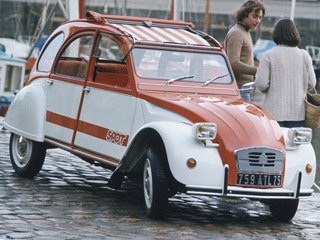Think of the Citroen 2CV as a slower, less popular and French Volkswagen Beetle. You could also think of it as a cardboard box with a lawn mower engine in it without being too far off. There have been quite a few attempts, since the invention of the automobile, to make cars that nearly anybody can afford. Some have been more popular than others, and the 2CV was one of the more popular ones. It was quite innovative as well, but that doesn't make it good. The Ford Model T really did seriously change the world.


It was the first really big en masse move from horses to cars, and a number of other manufacturers wanted to do the same. The Model T would become obsolete before managing to completely replace the horse everywhere in the world, and in the Thirties, a number of European companies would begin work on updated versions of the same idea embodied in the Model T. These would later result in such classics as the VW Beetle and the Mini, but during the early stages of development for some of these cars, there would be a lot of guesswork. The story of the 2CV actually starts as far back as 1922, and with a different company. It was in this year that the tire manufacturer Michelin first began to consider going into the car making business with a small economy car. Michelin would acquire Citroen in 1934 after one of its many bankruptcies, and Pierre Michelin would set in motion a small economy car project, headed up by Pierre-Jules Boulanger, who was obsessed with lightness. Whenever a new component was developed for the car, he had a separate department which would weigh it and then try to figure out a way to make it lighter. So complete was this obsession that the 1939 prototype didn't even have seats, instead using hammocks suspended from the roof.


The project hit a bit of a snag when France was invaded by Germany during the Second World War. Boulanger hated the Nazis, and hid his work from them, less out of preservation of corporate secrets and more out of the fear that it would be turned into a weapon. It never was, but the hiding did mean that work could resume fairly quickly after the end of the war, and the completed project would debut in 1948. The car had a two-cylinder air-cooled boxer engine located in the front, which produced a whole 9 horsepower. It's true that the 2CV only weighed 1,200lbs (about 150lbs less than an Ariel Atom), but 9 horsepower is still fairly laughable.Later, more powerful versions would produce 12, 18, 29 and finally 35 horsepower, still pretty sad when compared even to the Beetle. The press scoffed at the car, but in an era when Europe had been financially (as well as in several other ways) ruined by WWII, the 2CV was just the sort of thing people needed. It was the most basic of transportation, but that was just what people wanted as well. It would actually stay in production all the way up until 1990, with 3.8 million units produced over its lifetime. Several other models based on the 2CV were also produced which were mechanically identical.


If you total up all these variations, Citroen sold about 8.7 million units of the car. This is only slightly more than half the number that Ford sold of the Model T, and it's not even in the same league as the Volkswagen Beetle, but it is still probably the most iconic French car of all time. Much like the Beetle, the 2CV would become quite popular with hippies, particularly in the UK. Since the car was still sold new there much more recently than the Beetle was in the US, it is still thought of there as a hippie car, while in the US they seem to have all moved on to the Prius. As you might expect, it was safety regulations which killed of the 2CV.This is one of those times when enthusiasts don't get too worked up about it. The car actually wasn't so bad in front-end collisions, since the design accidently created a crumple zone forward of the A-pillars, but in any other kind of collision, it was the passenger compartment which would crumple. Not only that, but the car was so light that if the slab-sided body caught a strong enough wind, you would suddenly find yourself in another lane. So the 2CV might have been important to postwar Europe, but it was painfully slow, hideously unsafe, and most of the remaining ones smell like patchouli. Sounds like some good reasons to pass.


Nouvelles connexes



